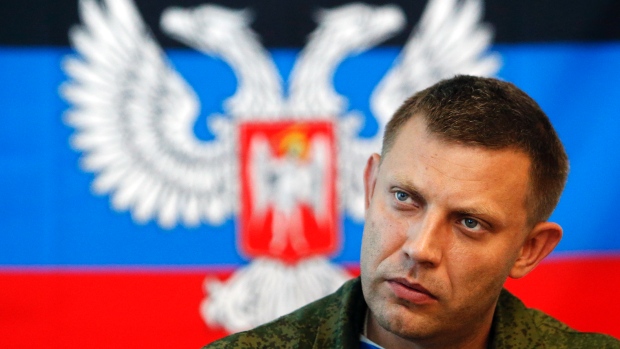
Russia Wields Upper Hand in Ukraine’s Donbas Post-Armistice
Publication: Eurasia Daily Monitor Volume: 11 Issue: 163
By:

Russia’s war against Ukraine is a multi-dimensional conflict undertaking. It has come to a standstill on the battlefield in Ukraine, but continues nonetheless in its military aspect (below the combat threshold) and in its political, economic, propaganda, and cultural aspects. Russia’s overall objective is to halt and reverse the completion of Ukraine’s nation formation, state-building, and orientation to the West.
The ceasefire protocol, signed on September 5, gives Russia the upper hand over Ukraine and its Western partners for the time being. Having annexed Crimea in the spring, Russia is now slicing de facto a part of Donbas (region encompassing the Donetsk and Luhansk provinces) from Ukraine. The ceasefire document allows wide scope for Russia to press its military advantage farther afield and use its Donbas proxies to extort political concessions from Ukraine (Ligabiznesinform, September 15).
The situation in Donbas is developing along the generic pattern of “frozen” (or simmering) conflicts. However, Ukraine is worse off in several respects, compared with Russia’s other target countries. Russia has annexed Crimea outright (which it has not done officially to the point of irreversibility elsewhere). Donbas is not only far larger than other territories seized by Russia and its proxies, but it is crucial to Ukraine’s gross domestic product and national budget. Russia no longer even pretends to abide by Ukraine’s territorial integrity (nor do Western powers seem to maintain that position with the same consistency as in the pre-existing “frozen” conflicts). Uniquely in Ukraine’s case, the Kremlin contests the existence of a Ukrainian nation distinct from the Russian. Uniquely again, Russia seeks to use Donbas as a starting base from which to carve out a far larger territory from Ukraine (the country’s “south-east” or Novorossiya).
The ceasefire protocol (see EDM, September 10, 11) has the status of a framework document, to be fleshed out by specific agreements in follow-up negotiations on military, political and, probably, economic issues. The framework document omits any mention of Ukraine’s territorial integrity and its sovereignty within internationally recognized borders. These norms were traditionally referenced in such negotiations, when Russia paid at least lip service to such norms. But Russia no longer deems this expedient; and the Organization for Security and Cooperation in Europe (OSCE—the custodian organization of these norms in Europe) failed to have these norms referenced in the document.
By the same token, the ceasefire document marks the first step toward legitimizing the leaderships of the two secessionist territories. The protocol stipulates obligations for the Ukrainian government and, reciprocally, for the Donetsk and Luhansk “people’s republics” (DPR, LPR). The document does not refer to the DPR and LPR by name yet, but it inserts their Moscow-appointed leaders into the negotiating process, as counterparts to Ukraine’s legitimate government. These leaders and their entities will probably be further elevated in status when they sign the follow-up agreements with Kyiv as planned.
The armistice stipulates no obligation for Russia. Instead, it sets the stage for aggressor Russia to evaluate Kyiv’s—the aggressed party’s—fulfillment of armistice terms, on a par with the “DPR-LPR.” Furthermore, Russia receives a free pass to maintain its forces (along with proxy forces) on Ukraine’s territory in Donbas. The protocol’s Point 10 calls for “removing the unlawful armed formations, [their] heavy equipment, as well as paramilitary fighters [boyeviki] and mercenaries, from Ukraine’s territory” (osce.org, accessed September 16).
That formulation does not cover Russia’s own troops and hardware. The DPR-LPR have already declared their armed formations to be no longer irregular, but an “army” of their own (to obscure the Russian sources of their weaponry and skilled personnel). Undoubtedly they will redefine their military personnel from Russia as “local residents” of Donbas; and no outside authority will ever be able to disentangle the Russian military personnel from the “locals.”
The Contact Group (Ukraine, Russia, DPR, LPR, OSCE) worked out the ceasefire document and went on to create working groups for follow-up agreements on: the rules of an armistice regime and its supervision, the status and powers of “certain districts of the Donetsk and Luhansk provinces” (i.e., DPR-LPR-controlled territories), and surveillance of the Russia-Ukraine border. The Russian side will predictably argue that a sustainable armistice and a secure border require the DPR-LPR’s cooperation. Moscow will likely try to insert the DPR-LPR into the negotiations on the armistice regime and border surveillance, so as to obtain de facto acceptance of its proxies by Kyiv and internationally via the OSCE.
At present, the DPR-LPR control one third of the combined territory and one half of the combined population of Ukraine’s Donetsk and Luhansk provinces. On September 15, complying with the ceasefire document, President Petro Poroshenko submitted draft legislation on a special status and powers for those “certain districts.” On September 16 the Ukrainian parliament promptly approved that legislation (Ukrayinska Pravda, Ukrinform, September 15, 16).
That legislation passed without serious challenge as to its constitutionality. The constitution, however, does not authorize conferring any special status or special powers on a territory of Ukraine. Under the constitution, Ukraine is a unitary state, with the single exception of the Autonomous Republic of Crimea (officially annexed by Russia in March). Ukraine consists of 24 provinces, along with the cities of Kyiv and (Russia-annexed) Sevastopol. The legislation adopted on September 16 is a hasty move of sheer expediency. The terms of the armistice have apparently compelled Ukraine to resort to this legal shortcut, to its own detriment. It may, however, fall short of satisfying the Donetsk and Luhansk “people’s republics.” These will probably demand a more far-reaching and mutually negotiated special status, not a unilateral grant of status by Kyiv.




